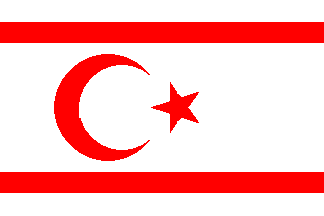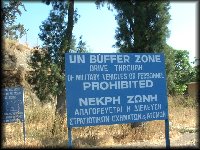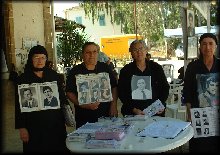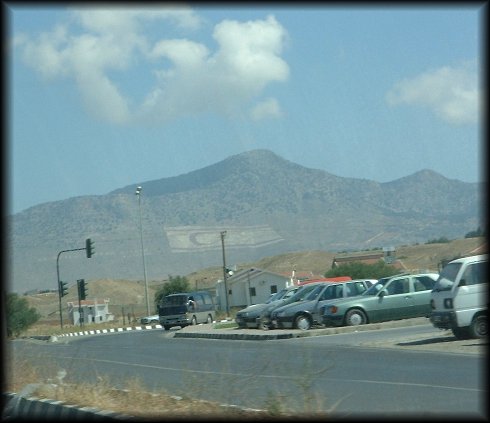 North
Nicosia: Closing a 83,000,000 deal in a Rebel Capital
North
Nicosia: Closing a 83,000,000 deal in a Rebel CapitalA Rush Across History & Fault-lines of the North & South
 North
Nicosia: Closing a 83,000,000 deal in a Rebel Capital
North
Nicosia: Closing a 83,000,000 deal in a Rebel Capital
We
closed a 83,000,000 deal in a matter of minutes, with all sides satisfied.
Couldn't squeeze in any equity warrant or convertible option. But we got
it settled in cash and that's all it matters in such desolate frontiers.
You won't want to spend too much for some complicated forex swap to hedge
any extended exposure. Such deals couldn't be easier, especially in Lefkosa, the
Turkish name for (north) Nicosia, capital of the unrecognised Turkish Republic
of Northern Cyrpus (TRNC), a political entity created as a result of the 1974
operations by Turkish forces. Whilst
the Greek-dominated Republic of Cyprus recovered from the mayhem of the Turkish
march which displaced half the Greek population and went on to prosper from
tourism and financial services (read "money laundering"), the northern
1/3 of the island sunk into economic abyss with the lack of foreign investments
and the burden of a pathetic Turkish economy.
With the collapse of the Turkish lira late last year, we are paying TL
83,000,000 or about US$75 for a full day taxi tour of TRNC.
We arrived in the sunny Republic of Cyprus at 4am Saturday morning. Hopped onto a rented car driven at 150 km/hour, thus reaching Nicosia (now renamed Lefkosia by the Greek Cypriots) in 20 minutes as opposed to the normal 45 minutes. Dumped our stuff at a mosquito-infested outfit called Tony’s B&B (which Lonely Planet recommended – they aren’t right all the time; anyway we were to move to cleaner, unlisted Rimi Hotel next door) and then aimed straight for the Green Line, the ceasefire line between the Greek and Turkish Cypriots policed by the UN today. As we neared the Green Line, flashy hotel facades and kitschy fast food kiosks suddenly gave way to run-down buildings with faded paints and sandbag bunkers, the only vestiges of brightness of which were the bright blue national colours of Greece. Young conscripts from Greece perform their National Service here in Cyprus, officially a separate country. Cypriot and Greek flags flapped above the bunkers. In fact I have probably seen more Greek flags than Cypriot ones. Seems that the Republic of Cyprus makes no secret of its Greek-orientation on the frontlines, while maintaining the image of being the only legitimate cross-racial body on international propaganda and diplomatic circuits. Indeed, as I was to discover, the Cypriot flag regains its prominence on the much-touristed coastal resorts, for that’s the image it probably prefers to show the world.
“UN Buffer Zone” “Protected Area” “No Photos – No Video” The loud notices proclaimed as we hit the UN zone. Bored young faces in uniforms manned the watch towers in this most touristy and unwarlike of warzones. These handsome lads must be dying for the day to be over, slip across to either (or both) sides of the Line to meet their girlfriends, mistresses and what-have-you. Frontiers must be wonderful places for those who doubletime, as the other party would find it difficult to discover the rival on the other side of the barb-wired line.
 |
 |
 |
| Signboards at the ceasefire zone | Elderly Greek ladies mourning their dead relations | Turkish Cypriot flag carved out on the mountain slopes. |
Walls on the Greek side were adorned with pictures of Turkish atrocities (what about Greek atrocities ?) and the traveller was greeted by elderly ladies in black mourning dress holding photos of their missing loved ones (- victims of the barbaric Turkish invasion, as they called it) and handing out propaganda leaflets. Greek leaflets tend to highlight the struggle against British and Turkish Ottoman rule while ignoring the breakdown of constitutional order in 1963, when the Greek-inspired change of Constitution deprived the Turks of their privileges, thus leading to communal fighting and stationing of UN troops. Nevertheless I still find it hard to accept the uprooting so many people in order to uphold the rights of a minority that comprises less than 20% of a nation’s population. But again, the Turkish Cypriot population could well have been faced with a genocide of sorts in 1974 if extremist Greeks had their way and Turkey didn’t invade to save their ethnic brethren. And yet, this is such a small land - there are only slightly more than 600,000 Greeks versus 150,000 Turks, with the latter supported by 50 million Turks from Turkey proper. The supposed genocide could have happened both ways round. This apparent calm aside, tension rises from time to time, coupled by occasional incidents, the last of which occurred in 1996, when a young Greek ran over to the Turkish side, pulled down the Turkish flag only to be beaten to death. A few more deaths followed in the next few days. Cruel but I doubt anyone would have allowed someone to desecrate one’s national flag.
Certainly the Greek Cypriots did not like people crossing to the other side and the rules were duly disseminated to the traveller – be back by 5pm, do not buy anything in the occupied zone, do not allow your passport to be stamped by the other side (i.e., no stamping by illegal states allowed). Tourist maps even highlighted the Turkish zone as “Inaccessible due to illegal Turkish occupation” and the northern Ercan Airport was denounced as “Certified unsafe” – what a sham given that the Turkish Cypriots welcome tourists with open arms and that scheduled and charter flights arrive here from major international airports. All these reminds me of China’s somewhat crude harassing of Taiwan in international circles.
The
moment we entered the borders of the TRNC, we were greeted with glossy posters
of the sun, sea and more Turkish edition. The
immigration office was staffed with friendly unveiled girls one of whom was
dressed in such tight skirts that it looked as though the twin bulky weights on
her chests were about to burst anytime. The
stern stare of Turkey’s founding father Ataturk shone from the walls,
reminding one that this is a secular state where religion is something to tuck
away at home rather than to proclaim and glorify.
With
the TRNC entry pass on hand, we negotiated the 83,000,000 Turkish lira deal, and
proceeded to explore TRNC in a taxi. While
my travel companions dozed off from the overnight flight, I had a lively
conversation with Mehmet the driver. Mehmet
proclaims himself Turkish Cypriot (as opposed to Anatolian Turkish – the
mainland Turks have flooded the island since the arrival of the Turkish army),
and more Cypriot than Turkish. We
eat the same food and know each other’s languages, he asserted.
We are one nation and yet not quite one.
Beneath this proclamation of togetherness, however, was pride in a
separate identity and the desire to defend that identity through armed struggle.
Human loyalties are flexible at best.
A Turkish passport hardly gets one anywhere without a visa, while a
Turkish Cypriot visa gets one no further than Turkey.
Practical Mehmet, like many TRNC citizens, has three passports – that
of Turkey and TRNC, as well as the hated Republic of Cyprus, for the latter
confers visa-free privileges to Western Europe and elsewhere.
The Greek government of the South, in order to assert that it is the sole
legitimate government of the island, continues to issue passports to its
supposed ethnic Turkish citizens in the North.
With
Mehmet, we rolled across the flat Mesaoria plains south of the Kyrenian
Mountains, where a large TRNC flag was carved out from the mountain slopes –
large enough to spat at the inhabitants of Greek Nicosia. We stopped by Barnabas
Church whose icons have become museum exhibits after the departure of its Greek
guardians. And the ancient
classical city of Salamis, whose wealth attracted Alexander the Great; and
Cleopatra, who received it as a present from Mark Anthony; and poor me, with my
shoes giving way amongst these desolate ruins and lonely columns.
Richard the Lionheart came as well, ravaged and plundered the island on
the First Crusade – that overglorified king of the English is regarded as a
murderous villain in these parts rather than a chivalrous, benevolent king. To the Crusader knights, the Orthodox Christians are no
different from Muslim and Jewish pagans – all to be killed and plundered in
the name of God. Indeed Greek
Orthodox believers still remember the Crusaders as an evil force.
Pope John Paul II is visiting Athens right now and local Orthodox
Christians are protesting against the visit and the sacking of Constantinople
900 years before. In the nearby
southeast of Cyprus, a momentous struggle is continuing on the Asian Mainland.
To the Christian and Muslim Arabs of Palestine, a different crusade of
sorts is continuing – Jewish warriors backed by Protestant Americans are
ravaging their land and people; whereas the latter groups believed in their
God-ordained rights to the Holiest of Lands.
Turkish and Turkish Cypriot flags on Girne Castle
We
proceeded to the city of Famagusta, once the richest city on Earth, where the
dispossessed King of Jerusalem, Guy de Lusignan feted and partied in his new
capital; where Othello, the Black General ruled the great Venetian trading port
and its legendary riches, I spent the princely-sounding sum of TL 13,000,000 (or
US$11) on a pair of shoes. In the
20th century, Famagusta had lived through its glorious days as the
party beach of Europe. After the
1974 Turkish intervention which drove away its mainly Greek inhabitants, streets
lie barren and deserted. A massive
ghost town of sorts stood in the southern suburbs of Famagusta, waiting for its
owners to return. A long, endless
wait.
There
upon we rushed across the mountains to fair Kyrenia, now known as Girne.
A pity we didn’t have enough time for the quaint marina of Girne, which
looks most inviting, with nice cafes and seafood restaurants gracing the quay.
As we rushed back to Nicosia to beat the 5pm deadline, a gush of feelings
overcame me. This warm, friendly
people have finally secured their liberty in the North, but the social costs
have been heavy – for themselves as well as their enemy.
Both ethnic groups have always lived across the island – now the North
has been ethnically cleansed of the Greeks and the South the Turks.
The old cosmopolitan, multiracial Cyprus no longer exists. The North have become a sleepy Turkish provincial town while
the South yet another Greek holiday island resort.
As sun sets over the bell towers and minarets of Nicosia, I mourn for a
Cyprus lost forever.
Click here to send your comments to Tan Wee Cheng, Singapore
Click here to visit the author's homepage, Nomadic Tales